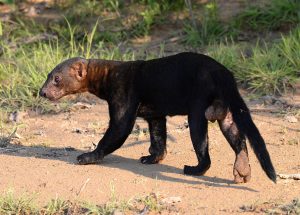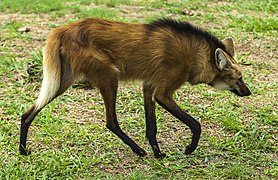Podcast: Play in new window | Download (Duration: 8:53 — 10.5MB)
Thanks to Dean, Mia, and Lydia for their suggestions this week!
The tayra looks kind of like a canid but is a mustelid [photo by Bob Johnson – Own work, CC BY-SA 4.0, https://commons.wikimedia.org/w/index.php?curid=85291909]:

The bush dog looks kind of like a mustelid but is a canid:

The maned wolf looks like a fox with reallllllly long legs:

Show transcript:
Welcome to Strange Animals Podcast. I’m your host, Kate Shaw.
This week we have a suggestion from Dean, who wanted to learn about the bush dog. We’re actually going to learn about two animals that share the name bush dog, along with an animal suggested by both Mia and Lydia, the maned wolf.
We’ll start with the bush dog that isn’t a dog. It’s more commonly called the tayra and it’s native to much of Central and South America. It prefers to live in forests, especially tropical forests, but it will travel long distances to find food and can sometimes be found in grasslands and other areas. Despite the name bush dog, it’s not a canid at all. It’s a member of the family Mustelidae, which includes weasels, ferrets, and wolverines. The tayra has a long body and short legs, but it’s also bulkier than most mustelids, more similar to a wolverine. It can grow almost four feet long, or 1.2 meters, including its long tail, and its fur is short and black or dark brown. It also has a patch of lighter fur on its chest that’s a unique shape to every individual, sometimes called a heart patch.
The tayra is mostly active during the day and does a lot of climbing around in trees, where it eats birds, lizards and other reptiles, small mammals, eggs, fruit, honey, and large insects and other invertebrates. It especially likes plantains, which is a type of banana. The tayra will pick green plantains and hide them, then come back to eat them after they ripen. It’s also really good at catching spiny rats, so good that the indigenous peoples in various places would sometimes tame a tayra or two in order to keep spiny rats and other rodents away from their food stores.
The bush dog that is actually a canid is also from South America, but we’re going to start not with the living animal, but with an extinct one. Back in the 19th century, when it was possible to specialize in several fields of science at once, a Danish man named Peter Wilhelm Lund made a name for himself as an archaeologist, a paleontologist, and a zoologist. He moved to Brazil in South America in 1825, went back to Europe in 1829 to finish his doctoral degree, but returned to Brazil in 1832 for the rest of his life. He just really liked it there. He described hundreds of Brazilian plants and animals scientifically and is most well known for his studies of extinct ice age megafauna, along with prehistoric cave paintings.
One of the animals he described was an unusual canid. He discovered its skull in a cave in 1839, so he called it the cave wolf. That makes it sound scary and impressive, but it was actually a fairly small animal. He gave it the scientific name Speothos pacivorus, which means “cave wolf hunter.”
In 1842 Lund described a living canid with a similar skull, although its teeth weren’t as big and it was even smaller than the cave wolf. But he didn’t quite make the connection and placed the living animal in a completely different genus. In 1843 another scientist renamed the animal but again placed it in a completely different genus from the cave wolf.
It’s not unusual for an animal to be studied repeatedly and its taxonomy debated by various scientists as they try to figure out what the animal’s closest relations are. But in the case of the bush dog, it kept getting shuffled from genus to genus every few years, so that in the 180 years since it was originally described it’s been placed and re-placed in nine different genera, until it was finally renamed Speothos venaticus and recognized as a close relation, or possibly the direct descendant, of the cave wolf.
Although the bush dog’s ancestors lived in the highlands of Brazil, the bush dog alive today is adapted for forests. It has partially webbed toes that help it walk on soft soil around water, and it spends a lot of time in water. It’s brown all over, although some individuals have a patch of lighter brown fur on the throat, and its legs and tail are often darker. Puppies are black all over. Its legs are short and it has a short snout and small ears. It actually really does look similar in many ways to the other bush dog, the tayra, although its tail is shorter.
The bush dog is incredibly shy and lives in remote areas that are hard for humans to explore, so we actually don’t know a whole lot about it. It’s so shy that it’s even hard to catch on camera traps. It’s a social animal that sometimes hunts by itself and sometimes in groups, and it eats pretty much anything it can catch. Its main prey is rodents, especially large rodents like capybaras, but it also hunts peccaries, tapirs, and the large flightless bird called the rhea.
Part of the reason the bush dog kept getting moved from genus to genus is that it’s not very similar to other canids. The fact that it even looks a lot like a mustelid gives you an idea of how strange it appears. It has a cute puppy face since its snout and ears are so small, and its long chunky body and short legs make it look a little like a corgi. It’s only been recently that scientists have identified one of its closest relations, and it’s a canid you might not expect. It’s also the canid suggested by Mia and Lydia, because everyone loves the maned wolf.
We’ve talked about the maned wolf before, most recently in episode 167. The maned wolf looks kind of like a short-tailed fox with extremely long legs—like, twice as long as a regular fox’s legs or longer. But the maned wolf isn’t a fox and it isn’t a wolf, or a coyote, or a dog, or any other type of canid. It’s its own thing. It lives in the grasslands of central South America, and it needs extremely long legs to help it see over tall grass. It stands over three and a half feet tall at the shoulder, or 110 cm, while the bush dog only stands about one foot tall, or 30 cm.
The maned wolf is mostly solitary, although mated pairs will sometimes share a territory. It’s an omnivore and eats a lot of plant material in addition to hunting small animals that live in the grass. It especially likes a tomato-like fruit called the wolf apple, and it will also eat carrion. If it catches a large animal, or finds a large animal already dead, it will bury what’s left of the body to eat later. It marks the hole it digs with urine so it can more easily find it later. It also marks its territory with urine.
The maned wolf’s urine contains a chemical called pyrazine, which produces a strong smell. Since the smell of pyrazine is produced by many animals and plants that are toxic, it’s possible that having the smell in its urine helps keep other animals away from the maned wolf’s food caches and out of its territory. Humans recognize the smell of pyrazine as something else, marijuana, since the marijuana plant actually contains pyrazine. In 2006 someone at the Rotterdam Zoo in Holland complained that people were smoking marijuana in the zoo, but when police investigated, they discovered that the smell was actually coming from the maned wolf exhibit. This will never not be funny to me.
You can find Strange Animals Podcast at strangeanimalspodcast.blubrry.net. That’s blueberry without any E’s. If you have questions, comments, or suggestions for future episodes, email us at strangeanimalspodcast@gmail.com. We also have a Patreon at patreon.com/strangeanimalspodcast if you’d like to support us for as little as one dollar a month and get monthly bonus episodes.
Thanks for listening!